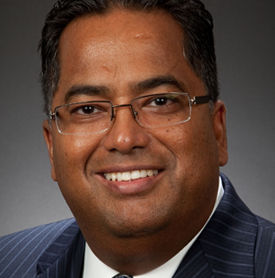There’s been much talk lately about non-commissioned financial planning and the international trends heading our way. But is fee-for-service or asset-based the way to go for advisors?
There are different sides to the issue: those who favour the traditional method of giving advice and selling a product from the same advisor and those who believe there is greater transparency and freedom from conflict-of-interest with fee-for service or asset-based financial planning.
“Actually, we are indifferent to compensation methods as long as we get paid fairly for the work that we do,” says Tony Mahabir, chairman and CEO of Canfin Financial Group of Companies, which provides fee-for-service, asset-based and commission-based financial planning. “We also believe in full, true and plain disclosure around services and compensation, not limiting the compensation options as each model really addresses a different client segment.”
Mahabir, a CFP and chair of the Canadian Institute of Financial Planners, had been commission-based for 15 years before incorporating the other two methods 10 years ago.
“As I evolved in the business, I realized I prefer to work with clients, listen to what their goals and plans are, crunch some numbers and provide options. Often times, my services are not product-oriented.”
Income took a dip
Mahabir said his income took a dip when he switched to fee-for-service, meeting some resistance from clients, and it took a year and a half for him to recover. He learned that it was all in educating his clients.
“For 15 years they had the perception that they were not being charged – which is an incorrect perception – and now suddenly they feel as if I’m doing this U-turn on them and going forward I will charge them for my time – well then, there’s a wall.”
Mahabir believes new advisors coming into a non-commissioned-based practice will find it difficult unless they already have an established pipeline – an accountant, for example, who has a clientele and wants to diversify into financial services. Those with no experience should get a few years under their belts working for an established advisor or bank before branching out on their own.
There are models available on how to transition, but advisors should not be surprised if only 20 per cent of their established clientele go with them if offered the fee-for service or asset-based options, he said.
“The advisor has to ask himself: if I run a fee-based model exclusively, are my clients going to be better off? Am I going to be better off over the long term? Will I still be able to have some contracts with product suppliers? All three parties have to win. If I switch to fee based and the client is the only one who wins and I go bankrupt in the process, I have not transitioned very well, have I?”
Certified financial planner Jason Heath moved into a fee-for-service practice about 12 years ago, put off by the “eye-opening” experience in the more sales-driven atmosphere of banking. One day, by accident, he noticed an ad for a fee-only financial planning firm in Markham, Ontario. “It was a beacon of light that kept me in the financial industry,” said Heath.
Personalized approach
Since then, Heath has been involved in a more personalized approach to financial planning that involves advice only, charging for the time it takes to do a specific task, whether it be creating a financial plan, or adding in extras, such as giving input into tax, estate planning and insurance needs.
Typically, there is a lot of homework on the part of a fee-only advisor, including much discussion of a person’s goals, dreams and family as well as pulling together information like tax returns and pay stubs to create a holistic plan.
“People accept the fact that a fee-only financial planner is not trying to sell them anything and there’s no conflict of interest. So they’ll spill all the beans right off the bat and it really makes for a satisfying relationship.”
Heath charges a flat fee based on the tasks he is required to do, a cost that can run into the “thousands of dollars” for a longer, comprehensive financial plan and the work associated with creating that.
“People understand that financial planning is becoming a professional service not unlike doing a will or settling an estate or having your income taxes prepared,” said Heath. “Professional financial planners charge professional fees not unlike the other professionals.”
After the initial plan is created, Heath said he generally sees a client once a year, but because clients pre-pay – in essence, paying a retainer – they can come to him at any time and won’t be billed for each call or email.
He said about half the time clients come to him because they are dissatisfied with the level of service they’re getting now. Another 25 per cent are those interested in doing their own investing, while the remainder are those who want a second opinion.
While he frequently makes referrals to a third-party to implement parts of the plan, he does not receive any referral fees, but can negotiate discount fees on behalf of his clients.
Many investors who go to fee-only financial planners are high net worth, but Heath said he is seeing an increasing number of “average” people coming to him because they appreciate his independence.
John De Goey, vice president and associate portfolio manager with Burgeonvest-Bick Securities Limited, is an asset-based financial advisor, charging a fee based on the amount of assets held by the client and the client’s spouse in personal and corporate accounts.
It took De Goey, a certified financial planner, some time to fully move into an asset-based practice. Because many of his clients had deferred sales commissions on their mutual funds, he moved them out by stages to minimize or eliminate the cost of switching from one business model to another. Like Mahabir, it took a while to explain to clients what he was doing. “I didn’t want to force them before they were ready. I wanted to nudge them and encourage them and explain to them without making them feel as if they were doing so against their will, but rather because they saw the logic in it.”
Resistance was stiff and he lost some clients, partly because his transition was in full swing around 2001 when the tech bubble burst and markets were down, but also because the asset-based model was new to them.
“Now it’s [more] mainstream,” said De Goey. “At that time, charging an asset-based fee was not unheard of but was extremely rare. I guess my clients were like the giant Petri dish of experimentation as to how this would all play out.”
About 80 per cent of his clients have between $250,000 and $1 million of net invested assets, with 10 per cent below $250,000 and 10 per cent above $1 million. He charges 1.4 per cent on the first $250,000 and a sliding scale over that, plus costs for trades.
De Goey said he would recommend new advisors move into a non-commission-based practice, as long as there is a spouse or other money that can get the person past the first five critical years. And, advisors under 60 should also make the switch, he suggested. The only ones who don’t have to worry about potential regulatory changes on this front are those five to 10 years away from retirement because he feels it will take that long before changes are adopted.
“There are lots of benefits for clients in this model,” he said. “There’s deductibility, scalability, transparency, access to a totally open product shelf and totally unbiased advice. There are a lot of benefits in moving this way, which I think is pretty much inevitable.”




